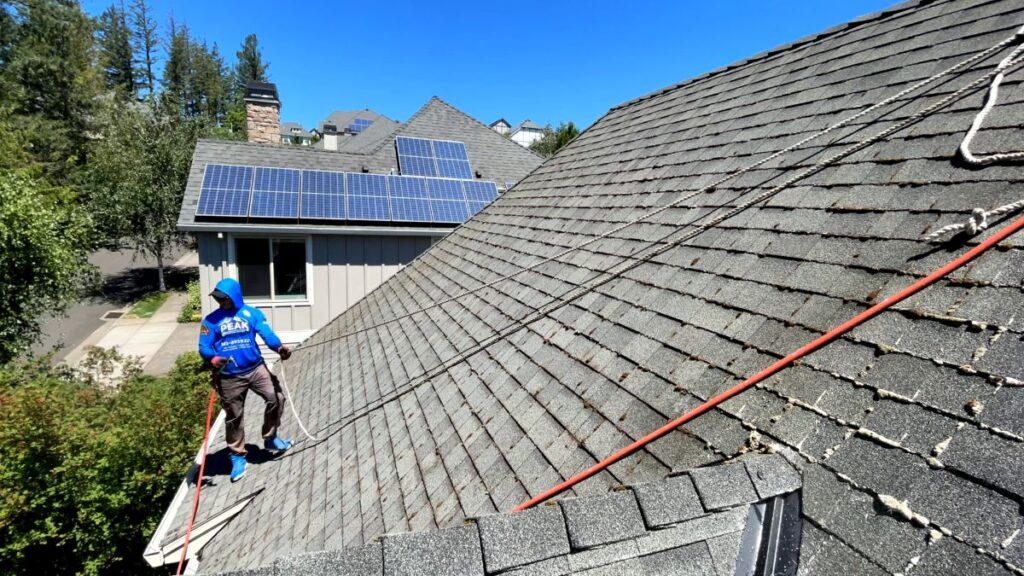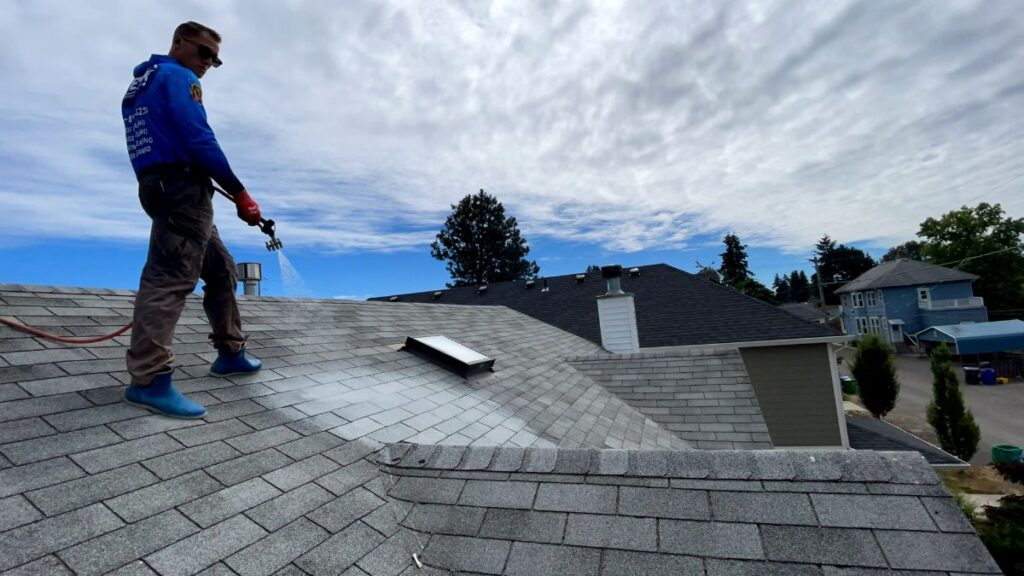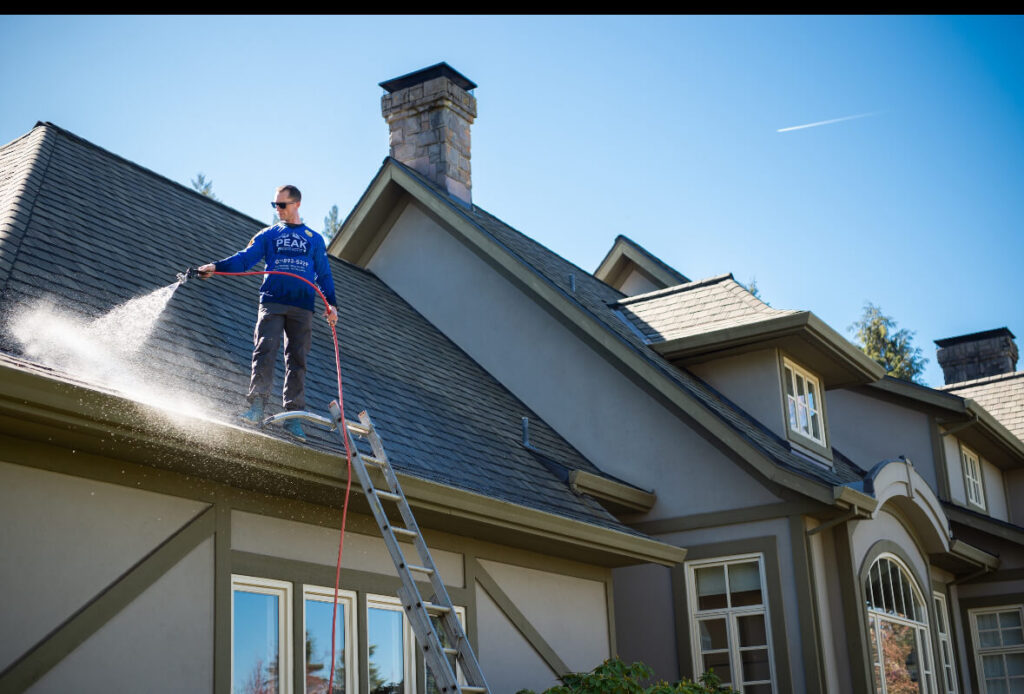Key Takeaways
- Wet climates accelerate moss, algae, and grime buildup on roofs.
- Soft washing is the preferred method to avoid damaging roofing materials.
- Regular cleaning enhances energy efficiency and roof longevity.
- Professional services ensure safe, thorough, and eco-conscious results.
- Roof maintenance is essential in the Pacific Northwest’s unique environment.
Why Roof Cleaning Matters More in Wet Climates
Homeowners in Oregon and similar wet-climate regions know how quickly moss and algae can take hold on rooftops. The constant moisture provides ideal conditions for biological growth that stains surfaces, traps heat, and slowly damages roofing materials. Regular roof cleaning isn’t just about appearances—it’s a core part of home maintenance.
Neglecting roof care in these environments leads to faster material degradation, structural issues, and even energy inefficiency. Algae and grime reduce a roof’s ability to reflect heat, while moss can lift shingles and allow moisture to seep into the underlayment.
In short, routine roof maintenance in a damp climate helps prevent costly repairs, improve property value, and keep homes functioning efficiently.
The Impact of Oregon’s Rainy Season on Roofs
The Pacific Northwest sees rainfall for nearly half the year. That much moisture, combined with shade from trees and cloud cover, creates the perfect breeding ground for:
- Moss: Retains water and spreads quickly, especially on asphalt shingles.
- Algae: Creates black streaks that stain the roof and reduce reflectivity.
- Lichen and Mold: Take root in organic debris and accelerate deterioration.
- Clogged Gutters: Overflowing gutters can direct water beneath the roofline.
Seasonal cleaning and maintenance become non-negotiable. Addressing biological growth early preserves the integrity of the roof while preventing collateral issues like leaks or insulation problems.

Soft Washing vs. Pressure Washing: What Works Best?
There’s a common misconception that high-pressure washing is the most effective way to clean a roof. In reality, pressure washing can strip away granules, dislodge shingles, and void manufacturer warranties.
Why Soft Washing is Preferred:
- Uses low-pressure water combined with specialized cleaning solutions
- Effectively removes moss, algae, and stains without damaging shingles
- Safer for fragile surfaces, especially on older or composite roofing
- Helps preserve roof coatings and manufacturer warranties
Professional soft washing services also ensure that cleaning agents are properly applied and rinsed, minimizing runoff and avoiding damage to landscaping.
Eco-Friendly Cleaning: Safer for Your Home and Environment
Homeowners today are increasingly aware of the environmental impact of maintenance choices. Fortunately, many modern roof cleaning solutions are both effective and eco-conscious.
Sustainable Cleaning Products:
- Biodegradable surfactants: Break down grime without harming vegetation
- Hydrogen peroxide-based formulas: Kill mold and algae without caustic residue
- Non-toxic moss inhibitors: Prevent regrowth safely over time
Using these products ensures that runoff doesn’t damage plants or contaminate nearby waterways. Peak Pressure Washing is committed to using methods and solutions that align with these values—protecting both your roof and the environment.
Challenges of Roof Cleaning in Wet Areas
Maintaining a roof in the Pacific Northwest presents specific logistical and safety challenges:
Common Issues:
- Slippery surfaces: Moss and algae increase fall risks
- Steep roof pitches: Difficult for untrained individuals to navigate
- Persistent debris: Leaves and needles block gutters and valleys
- Leak risks: Damaged flashing or missing shingles allow water intrusion
Attempting to clean a roof without proper training or safety gear can be dangerous. That’s why hiring professionals is the most efficient and safest route.
Why Hiring a Professional Beats DIY Roof Cleaning
While it might be tempting to grab a ladder and hose, roof cleaning is not a typical DIY job—especially in wet climates.
Benefits of Working with Professionals:
- Proper Safety Equipment: Harnesses, ladders, and fall protection
- Trained Eyes: Professionals spot damage early
- Effective Methods: Specialized tools and cleaners for stubborn growth
- Long-Term Protection: Moss inhibitors and sealants that prevent regrowth
Peak Pressure Washing offers all of this with minimal disruption to your home or landscape. Their experience with Pacific Northwest roofs means they understand the exact timing, technique, and tools needed.

Best Times to Clean Your Roof in Oregon
Choosing the right season for roof cleaning makes the job safer and more effective:
- Spring: Clear winter debris and prepare for spring showers
- Late Summer: Remove organic buildup during the dry spell
- Fall: Prep for rain-heavy months and eliminate leaves/moss
Avoid cleaning during heavy rain periods or in freezing temperatures when cleaning solutions may not work properly. Working with local professionals ensures the job is timed right for your climate.
Preventive Measures to Keep Your Roof Clean Longer
In between professional cleanings, homeowners can take small steps to reduce buildup:
- Trim back overhanging branches: Reduces shade and leaf fall
- Clean gutters regularly: Prevents overflow onto roofing
- Install zinc or copper strips: These inhibit moss and algae naturally
- Check attic ventilation: Poor airflow can promote mold inside the roof structure
While these don’t replace professional care, they extend the lifespan of a roof cleaning and delay the return of visible staining.
The Future of Roof Cleaning in the Pacific Northwest
As more homeowners prioritize sustainability, the roof cleaning industry is evolving. Innovations like drone inspections and smart moss sensors may soon streamline the maintenance process.
Meanwhile, the continued adoption of:
- Low-impact, biodegradable solutions
- Soft-wash systems
- Preventive coatings
…will allow homeowners to maintain their roofs without harming the ecosystem. Staying proactive now means fewer headaches later.
Frequently Asked Questions
How often should I clean my roof in Oregon?
At least once every 12 to 18 months. Heavily shaded homes or areas with frequent rain may require more frequent cleaning.
Can I pressure wash my roof safely?
It’s not recommended. High-pressure water can damage roofing materials. Soft washing is a safer, more effective alternative.
Are eco-friendly cleaners effective?
Yes. Many non-toxic, biodegradable solutions are designed to kill moss and algae without harming your roof or garden.
How long does a professional roof cleaning take?
Most homes can be completed in a few hours, though time varies based on roof size, pitch, and buildup.
Will roof cleaning damage my landscaping?
Professionals take steps to protect plants and use solutions that won’t harm surrounding vegetation.
Routine roof maintenance is essential in Oregon’s wet, moss-prone environment. With the right approach and professional support, homeowners can keep their roofs clean, functional, and beautiful year-round.
Peak Pressure Washing brings expertise, eco-friendly solutions, and proven results to homes throughout the Pacific Northwest.

